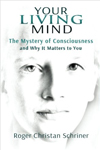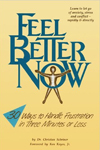I wrote Feel Better Now: 30 Ways to Handle Frustration in 3 Minutes or Less 20 years ago. In my psychotherapy practice I was fascinated by new pathways to personal growth – practical ideas and techniques for enhancing the quality of life.
Feel Better Now can be read as a straightforward self-help manual, but those who reflect more deeply upon the text will find an undercurrent of Buddhist thought woven throughout.
Here are excerpts from Chapter One. When material has been omitted I have indicated the missing text with ellipses: ..
Chapter One: Feeling Good and Doing Fine
Recently I offered three hours of counseling at a fund-raising auction for charity. The two highest bidders wrote their checks to the charity, and I scheduled stress management sessions with each of them. Ironically both of them canceled their sessions before the first meeting. They were afraid that finding time for the appointments would add more stress than the counseling sessions would alleviate!
I understand their predicament. In the most tension-packed era of history, people don’t have time to relax. Part of the problem is that most relaxation techniques take too long to use in the middle of a crisis. When the boss blows up or the radiator boils over, we can’t just wander off and meditate under a tree. The ability to cope with tension in minutes or even seconds is a basic requirement for emotional survival and physical health. Fortunately it’s a skill that we all can learn.
If we don’t neutralize our upsets as soon as they arise, a number of symptoms begin to appear. Which of these symptoms have you experienced?
l. I work hard to get everything done, but my chores are never finished. I’m always pushing to catch up.
2. I feel tight places in my body, and when I glance at myself in the mirror, I see strain and physical tension.
3. Work is stressful, or boring, or both.
4. I battle with bad habits, such as smoking, overeating, or overspending.
5. I’m haunted by regrets from the past, and worries about the future.
6. I need alcohol or sleeping pills to unwind after a rough day.
7. It’s hard to cut loose and have fun.
8. The world changes so fast it makes my head spin! I wish everything would hold still for a while.
9. I love my family and friends, but being with them is often dull or disagreeable.
10. I’ve made some real gains in my life, but I seldom feel proud of myself.
There’s good news and bad news about this list. The bad news is that most people identify with at least half of these items. The good news is that by using some very specific techniques we can feel better whenever we have a few minutes of cool-off time. We can relax and calm down while driving to work, making a routine phone call, picking up groceries, shaving, showering, applying makeup, or feeding the cat. We can turn these mundane moments into a personal time out, and bounce back, feeling good and doing fine.
A Recipe for Relief
What would be the ingredients for an ideal method of handling everyday tensions? Obviously it would have to be quick. After encountering a frustration, busy people frequently have three minutes or less of available recovery time before confronting their next responsibility. So a method for resolving problems on the go should contain no more than three or four simple steps.
The perfect technique would be free of negative side effects. It wouldn’t lower our level of energy or interfere with motivation. It would enable us to feel both relaxed and alert, at the same time.
You will find thirty techniques in this book that can ease frustrations in three minutes or less. No one is likely to need all thirty, but it’s still important to become familiar with them. A method that seems irrelevant today may be perfect for some high-pressure predicament week after next.
Most of these thirty methods could be described as ways of letting go. They enable us to release our tensions quickly, and move ahead into positive action. So in this book, to “let go” means to resolve an emotional upset, rapidly and directly.
Many of us assume that it’s hard to release upsets. Your mind may tell you that you can’t possibly cope with tensions any faster than you do already. Watch as it tries to convince you to hang on to regrets about the past and anxieties over the future. Then try out some methods for letting go, and see what happens.
Recognizing Your Own Progress
When learning something new, it’s important to give yourself credit for successes. Be sure to notice whenever you feel a decrease in frustration, stress, or physical tension. At first these changes may be subtle, so watch for the small improvements that let you know you’re on the right track.
You’ll spot these improvements more easily by developing a sort of emotional barometer–an internal signal that tells you when you’re starting to feel unhappy. The most reliable barometer is often a particular muscle that gets tight if you’re under stress. Does the tension first appear in your face, neck, shoulders, back, chest, or abdomen? Other early warning signs would include an increase in anxiety, a sense of pressure, or noticing that you’re holding your breath.
You’ll get lots of practice looking for these clues as you learn the methods of Feel Better Now. When you run into an upsetting situation, check your emotional barometer, do something to ease the pressure, and then check again to see if you released some tension.
This process itself is a way of letting go. It takes your mind off what’s bothering you, while you focus your attention within. And after you’ve calmed down, you may suddenly see how to solve the original problem.
How to Let Go
Although you’ll be learning thirty different ways of reducing tension, most of these methods fall into three simple categories. They’re either relaxers, distracters, or releasers.
Relaxers work by easing physical tension. We almost always feel better after our muscles loosen up. Relaxing techniques involve these three steps:
1. Set aside any problems you’re worrying about.
2. Use a relaxation technique from this book for two or three minutes.
3. Return to your activities, having taken the edge off the tension you were feeling before.
Distracters follow a similar pattern:
1. Set aside your problems.
2. Focus your attention on something completely different–a brief but total change of pace.
3. Return to your activities with a fresh outlook.
Releasers work in a number of different ways. These techniques have a sort of “triggering” effect that rapidly reduces muscular tension and emotional frustration. People who use these techniques may feel their burdens dropping away, as if a weight had fallen from their shoulders.
Reassuring ourselves with positive ideas is one way to trigger a release. Later in this chapter you’ll find a list of reassuring statements that work especially quickly. As another example, reminding yourself of previous successes in coping with tensions may act as a releaser. Remembering that we can reduce our upsets increases the odds that we will. We did it before, so we can do it again.
You’ll find examples of relaxers, distracters, and releasers in the next few pages. Feel Better Now also includes other approaches, such as positive thinking and accelerated problem-solving. Select the ones that work best for you. …
If You Are Using Medications
Any good program for coping with emotional upsets may affect one’s need for prescribed medications. If you’re taking any prescription drug, check with your physician about whether your dosage needs to be adjusted. Some drugs that might be affected include tranquilizers, antidepressants, insulin, muscle relaxants, pain medication, sleeping tablets, and high blood pressure pills.
A Sampler of Strategies
Although you’ve just begun this book, it isn’t too early to experiment with methods for resolving tensions rapidly. And as you continue reading, you will learn many shortcuts, so that you can use these methods with ever-increasing success. You’ll find out:
How to let go of stress in typical real-life situations.
How to avoid the pitfalls people encounter as they learn to let go.
How to spot a dozen subconscious reasons why people keep themselves unhappy.
How to let go of anxiety without sacrificing drive and determination.
How to remember to use your favorite strategies.
But even here at the beginning of the book, you can benefit by exploring the following techniques:
1. Take a Breather. Usually when we feel upset we begin to hold our breath. To release the breath is one of the most basic forms of letting go.
When you use this technique, put aside any problem that’s bothering you. You can come back to it when you want to, but there’s no harm in taking a break. Give yourself a three-minute time out in which you breathe slowly, softly, and deeply, closing your eyes if that’s appropriate. If you wish, count to five as the air comes in, and to seven as it goes out. (Spending more time on the exhale has a calming, soothing effect.) Imagine your stresses draining away, every time you enjoy that long, leisurely exhalation.
Take a Breather is a relaxation technique, and it also works as a distracter by shifting our thoughts away from problems for a few minutes. The next technique is a “releaser.”
2. Simple Affirmations. Repeating a short, positive affirmation can help us cope with emotional tensions. Here are a few examples:
Right this minute, I can begin to feel better.
I can be fully relaxed, and fully energized.
I always have a choice about the way I feel inside.
I can take the edge off tension, whenever I choose.
Life is too precious to waste on worry.
I’ll do my best, and accept whatever happens.
Deep down, I know I’ll be OK.
Try making up your own examples. Keep them short and keep them positive, avoiding negative words like “not” and “don’t.” Repetition is important. Repeat your affirmations for a few minutes at least once a day, preferably either out loud or on paper. Try out several affirmations, and see which ones relieve the pressure most rapidly.
Now here’s one more tension-releasing technique.
3. Take a Step. When we’re upset, it’s often because we don’t like something that’s happening (or that might happen), and we’re not sure what to do about it. It helps to ask yourself what one thing you can do to start moving in a positive direction. This first step may not solve the problem, but it’s hard to solve the problem without taking the first step. Action gives birth to hope, and hope gives birth to further action.
In case you have trouble deciding what to do first, here is a positive action checklist:
Write down all of your thoughts about the problem.
List your alternatives, and narrow the choices down to two or three.
Decide that the situation can’t possibly be changed, and begin to adjust to it. Tackle the most interesting or enjoyable part of the problem.
Tackle the easiest part.
Deal with the most urgent part.
Seek advice from an expert or an objective friend.
The three methods you’ve just read about can be combined in the following sequence:
1. Set your problems aside, and breathe softly and deeply for one or two minutes.
2. Every time you take a breath, repeat an affirmation such as, “Right this minute, I can begin to feel better.”
3. After calming down, decide whether you want to work on any of your problems. If you do, use the Take a Step technique. Remember to focus on what you can do to solve the problem, rather than on what you can’t do.
What to expect. At this point you can realistically aim at taking the edge off of minor physical and emotional tensions. You won’t get results every time, and sometimes the pressure may even increase because of anxiety about trying new techniques. At first, you may need to use a technique for up to fifteen minutes, but later it may work in seconds.
Try out all kinds of approaches. When you’ve discovered one or two methods that work especially well, use them repeatedly, going through the same procedure every time. Repetition makes the process easier and easier.
As you get better at letting go, your relationships will become more comfortable. You’ll find it easier to discipline yourself, so as to control overeating, overspending, and procrastination. You’ll develop increased self-esteem. But for now, just enjoy playing with some introductory techniques, and notice which ones work against the minor upsets you’ll be using for practice.
The next step is to discover your own most basic tension patterns, and that’s the subject of Chapter Two. [End of Chapter 1]
Feel Better Now is available from Personhood Press’ subsidiary, Jalmar, for $15.95, or purchase a signed copy from me for $20, tax and shipping included. For ordering information, email rcschriner@aol.com. For Jalmar click: http://personhoodpress.com/?wpsc-product=feel-better-now




